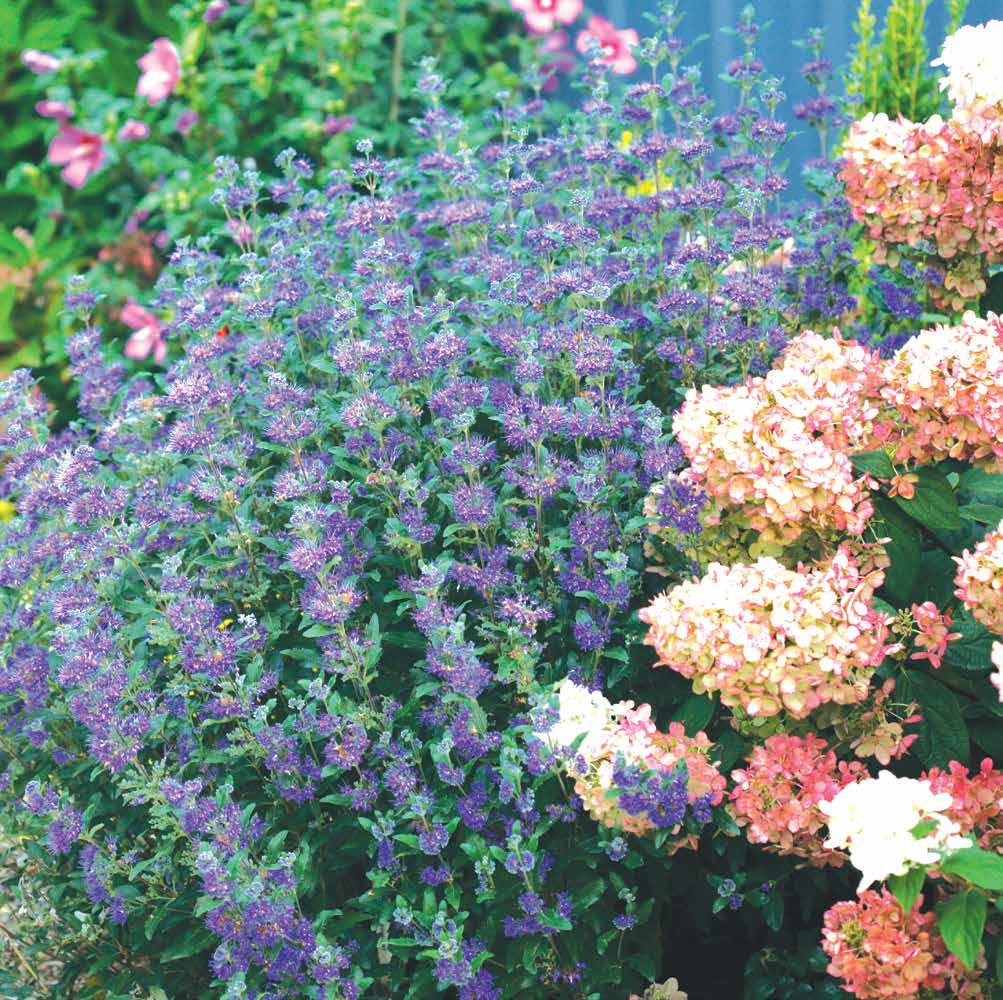
June 2024 | kcgmag.com GARDENER The Kansas City Berry Me on the Lone Prairie | Nesting Knowledge Rose Report | Days and Days of Daylilies | Summer Container Success Great Foundations How to Pick the Perfect Flowering Shrubs to beat the summer heat
The Kansas City
Independently owned and operated since 1996
PUBLISHER
Michael Cavanaugh
EDITOR
Elizabeth Cavanaugh
CONTRIBUTORS
Matt Bunch
Lois Hart
Lenora Larson
Anthony Reardon
Sarah Sikich
Corinda Stallbaumer
Elizabeth Stoakes
Ann Tanner
Julie Thompson-Adolf
Anne Wildeboor
DISTRIBUTION
Publishers Delivery Solutions, Inc.
IF YOU WOULD LIKE TO
DISTRIBUTE
the magazine at your place of business, please contact
Mike Cavanaugh at mike@kcgmag.com 913-648-4728
NEED MORE MAGAZINES? mike@kcgmag.com 913-648-4728
CONTACT US
P.O. Box 8725 Prairie Village, KS 66208 913-648-4728
ADVERTISING
Mike Cavanaugh at mike@kcgmag.com 913-648-4728
EDITORIAL
Elizabeth Cavanaugh elizabeth@kcgmag.com 913-648-4728
HOW TO SUBSCRIBE
See details on page 23.
SUBSCRIPTION
Elizabeth Cavanaugh
elizabeth@kcgmag.com 913-648-4728
WEBSITE kcgmag.com


Garden journal entry
n a Monday afternoon in May, I received this text from my youngest daughter. “I actually had so much fun planting trees and learned so much … The people were so nice and of different ages … Taking time out of their day to do something without reward, you know?”
She works for a national environmental consulting company, where she was invited to participate in a local tree planting event. Heartland Tree Alliance, a program of Bridging the Gap, frequently offers volunteer opportunities for individuals and groups, and provides all supplies and training. It’s a good thing training is offered considering this daughter is not a gardener—yet.
Her introduction to gardening started early. When she was young, she walked the garden with her dad, identifying plant names. She was fairly good at remembering, though sometimes mixing up the names that start with the letter h—like hydrangea, hosta and heuchera. There is one made-up name that always makes me giggle—latunia. It still gets a laugh at family gatherings.
What I love most about this little story is how genuinely excited my daughter was about her experience as a volunteer. What started out as “maybe it’ll get rained out,
and I won’t have to go,” turned into a fun, adventurous encounter with like-minded people. Maybe, just maybe, she will continue to explore volunteer occasions in the outdoors and discover a deeper connection with nature.
We received many messages of support for Mr. Gardener. Many of you have had similar disappointing experiences in the garden this spring, that I wrote about last month. To add insult to injury, a new driveway was installed, and the landscape took a beating. Mr. Gardener is none too pleased.
In defense of the workers, they were limited on places for machinery and tools, nevermind knowing where to step. The entire front landscape is all garden, no lawn at all.
The scene that remained was disheartening for Mr. Gardener. Once I found him with his head in his hands, looking defeated and in need of a friend. It’s overwhelming to think about all that needs reworking. “Where do I even begin,” he says.
I share this story to make this point. A new driveway is not delivered like new furniture, where it’s unloaded from the truck securely wrapped in protective covering. Then, mindful of your interior, the movers gently remove the old sofa, and slip in the new. A new drive-

way is not flown in with a helicopter or a crane and gently positioned on your property. The process is messy, and there will be carnage in the hosta bed. Had we considered those facts ahead of time, we might have been a little more prepared— at least mentally.
Not all seasons are blissful. In fact, some are downright maddening. Through it all, we believe our efforts are useful. Besides, a little frustration makes the joy that much sweeter.
I’ll see you in the garden!

the cover: Beyond Midnight® Caryopteris Bluebeard will brighten the garden as a
bloomer, is drought tolerant as well. See more drought-tolerant varieties on page 12.
editor’s notes
GARDENER
2 June 2024 | kcgmag.com About
late-summer
In this issue June 2024 | kcgmag.com 4 Ask the Experts 6 Berry Me on the Lone Prairie 8 Rose Report 10 Nesting Knowledge 12 Great Foundations: Flowering Shrubs to Beat Summer Heat 14 Summer Container Success 16 Invitation to Wonders of Discovery 18 Butterflies: Males or Females 20 Days and Days of Daylilies 21 Garden Calendar 22 Upcoming Garden Events 23 Subscribe 23 Hotlines
O


The Kansas City Gardener | June 2024 3
Question: I’m wondering how often I need to water my lawn with the summer heat on the way. I know excess moisture causes disease problems, but I also know my plants may need a cooling off. Any tips?
Answer: There are several factors to consider regarding hotter weather and maintaining a healthy lawn. However, it is important to know that more heat does not necessarily mean more water is needed. Checking soil moisture is going to be your easiest go-to guide with this. If a prod can reach two feet down, your soil is hydrated enough and does not need more water for the time being.
Also, remember that more foliage on the grass plants will likely result in more resilient plants and better-retained ground moisture. For this reason, the recommended mowing height of bluegrass and tall fescue lawns is between 3 and 3.5 inches. If you are mowing shorter than this, your plants will likely simultaneously become stressed in the summer heat while losing the water that is helping them. Allowing them to grow longer prevents the need for a cooling-off. Remember, it is also best to water your lawn between 4 a.m. and 8 a.m. for optimal summer plant health. While this may result in some weary early mornings for those without irrigation systems, it will encourage the most absorption and utilization of water by the plants and decrease the likelihood of disease development. With humidity more than likely accompanying that KC heat, any help you can get in mitigating disease appearance will be helpful.
BATTLING SQUASH BUGS
Question: I want to try my hand at pumpkins again this year, but I don’t know if the pain of battling squash bugs will be worth it. I also really hate using pesticides. Is there anything I can do?

Ask the Experts
Answer: Without the use of pesticides targeting susceptible nymphal stages of squash bugs, control will be tricky – but it isn’t impossible. If your pumpkins aren’t already planted, rotate the crops to a new location to avoid residual infestation. Your next step will be regularly monitoring the undersides of the leaves for eggs. Squash bug eggs are a shiny burgundy red and are generally laid clumped together in staggered rows. Though

The best time to water is between 4 and 8 a.m.
tedious, these can be hand-picked and ‘squashed’ for control.
If infestations continue to develop beyond this point, where nymphal stages of the pests are showing up on leaves and fruit, there is another option. A popular remedy many resort to is laying a flat board next to the plants in the garden. In the morning, the bugs will be congregated underneath it for warmth, leaving them vulnerable to being picked, dropped into soapy water, and discarded.
POWDERY MILDEW
Question: My lilacs and peonies get overrun with powdery mildew every year, though they seem to recover okay next year. Is this bad? Should I plan to do something about this?
Answer: Powdery mildew is
a fungal disease that frequently shows up in areas with too much moisture, too much humidity, or where irrigation lands on foliage and spreads fungal spores. For annual plants, mitigation efforts should be made as the decreased photosynthesis within the leaves can be a death sentence.
For deciduous perennial plants like lilacs and peonies, powdery mildew is a common occurrence that typically won’t harm the plants

The foliage of peonies can be subject to powdery mildew.
enough to be substantial before they go dormant. Once dormancy arrives and the leaves fall away, so does the fungal infestation. Thus, the best mitigation practice you can do is to rake up fallen leaves to decrease the presence of spores in the area, in combination with watching your irrigation practices.
If your deciduous perennials get infected again, know that the problem is mostly an aesthetic one instead of something lethal. If you are not seeing severe defoliation, Mother Nature will continue to be your fungicide.
DETERMINING DEFICIENCIES IN GROWING TOMATOES
Question: I babied my tomatoes like crazy last year, and they barely produced anything. What am I doing wrong? Do I have bad
soil? What else should I consider when growing tomatoes?
Answer: While soil is one factor that influences the success of a tomato plant’s production, many can be considered. Regarding soil, know whether the medium is hospitable to keeping an even moisture that is also well-draining. Nutrients should also be looked at to see if there are any deficiencies preventing fruiting or whether too much nitrogen has been applied, as over-

There are many factors to consider when growing tomatoes.
application of nitrogen on tomatoes results in excessive foliation instead of fruiting.
Elsewhere, pay attention to the environment’s effects on the plants. Are they receiving 6+ hours of direct sunlight as needed? Are pests and diseases running rampant, tampering with plant vitality? How has the weather been recently? Tomatoes prefer a temperature range of 65-85 degrees Fahrenheit. Above this, they stop producing fruit as they battle to stay alive through heat stress.
Also, look at what else has been done in your garden. Flowers must be pollinated to produce fruit. If a harsh pesticide has been utilized or no pollinator-friendly plants nearby, drawing in beneficial insects, lack of pollination could also be the culprit.
Anthony Reardon is the horticulture agent for Johnson County K-State Research and Extension. For free information fact sheets, visit www.johnson.ksu.edu, or call the Extension office at 913-715-7000.
4 June 2024 | kcgmag.com
ANTHONY REARDON Horticulture Agent
TIPS ON WATERING LAWN






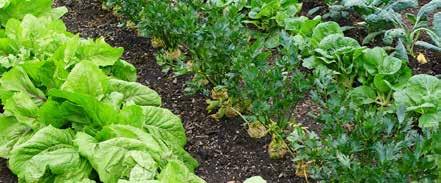










The Kansas City Gardener | June 2024 5 Find our great products in bags at all of our locations and at Sutherlands Lumber Ask about our installation of compost, soil and mulch! 816-483-0908 | missouriorganic.com Serving Kansas City – Since 1993 –5 locations to serve you 27610 E WYATT ROAD BLUE SPRINGS MO 816-229-1277 HANDPICKED & HANDPICKED & HOMEGROWN HOMEGROWN Spend the day with family and friends strolling our orchard and bramble patches for fresh seasonal fruits and flowers. Check the calendar below for what’s in season! While generally accurate, please note that the dates above are dependent on the crop and weather. Our peaches and blackberries in particular may arrive later this year. Connect with us on Facebook or sign up for our newsletter for updates! COLONIALGARDENS.COM SAVE $20 WHEN SAVE $20 WHEN YOU SPEND YOU SPEND $100 OR MORE! $100 OR MORE! KCGMAG.COM Tell them you saw their ad in The Kansas City Gardener. SUPPORT OUR ADVERTISERS!
Berry Me on the Lone Prairie
What is better than a big fruit? Well, a small fruit, of course! You will see small fruit plants at most of the Giving Grove orchards in Kansas City. The Giving Grove program at Kansas City Community Gardens (KCCG) has found that these small fruit plants give the surrounding community something to munch on while they wait for their newly planted orchards to take root (about 3 years), and they provide an early sweet and nutritious treat to kick off the growing season year after year.
As it so happens, June is when we can expect many small fruits to come to harvest. Blackberries, raspberries, black raspberries, blueberries, strawberries, gooseberries, currants, juneberries, oh my! Some berry plants are easier to grow than others, and some are much more rewarding to grow yourself! So, what small fruits can we grow here? Well, let’s berry ourselves in the information.
Strawberries: There are hundreds of varieties of strawberries on the market. As May begins, we see the initial flush from the early varieties (aka “June-Bearing”) like Sweet Charlie. For “Junebearing”(really May-June for us), I like Cavendish and All-Star; both are disease-resistant, vigorous and bear significant crops of large berries. For everbearing varieties (varieties that produce a flush in late May and subsequent smaller crops in July and September), I prefer Eversweet. Everbearing strawberries need more care, fertilizer, and water throughout the growing season to sustain fruit production. As for “Alpine” strawberries? Leave them in the Alps! The fruits are small, and the plants hate our summer heat. If you are looking for a “permaculture” strawberry, look no further than our native Fragaria virginiana. It is a vigorous groundcover with the taste of a strawberry on flavonoids!
Blackberries: Be-gone thorns!

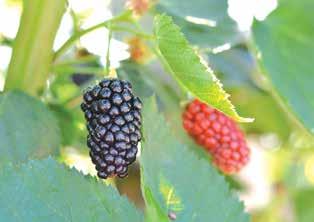

Since the 1990s (when thornless blackberry breeding took off), there have been many great thornless introductions, such as Triple Crown, Chester, Apache, and my favorite recommendation, Natchez. All of these are Floricane varieties (they bear fruit on 2nd year canes in June-July). Most Primocane varieties (fruit bearing on 1st-year canes) will not yield well in our area. It is recommended that all blackberry varieties be trellised on a clothesline-style structure. This structure helps support fruit weight and train the following year’s canes. Trellising also helps with cane management, as fruited canes must be removed for next year’s crop.
Raspberries: There are many varieties available! Caroline and Heritage are the standard for red ripening Primocane varieties (new canes in March yield berries in late July to first hard freeze). If you are looking for a thornless variety, con-


sider Joan-J. The berries are huge, without the prickles of a standard raspberry. Raspberries benefit from support but do not need to be trellised like blackberries unless you grow some floricane varieties.
Black Raspberries: Not a hybrid! But its own species, Rubus occidentalis. This plant can be found along wooded edges throughout the region. The flavor of black raspberries is uniquely its own; it has a raspberry flavor but with more puck. Most black raspberries are susceptible to anthracnose, a debilitating cane fruit disease (except for the “Jewel” variety), and all are incredibly thorny (except for the new cultivar “Tahi”). Because the fruits are not found in stores and demand top dollar in farmer’s markets, you should try to grow this one at home.
Blueberries: Everyone wants to grow these! If that sounds like you, you will want to ensure your
soil is well amended to a pH of 4.55.5, moist but well-drained, and your plants have drip irrigation. This often means adding peat, soil sulfur, and extra organic materials. Blueberries are fussy but take to containers well and can be incredibly rewarding. Successful varieties are Bluecrop, Reka, Duke, and Liberty.
And yes, there are so many more small fruits and berries that we can grow well around here: aronia berry, elderberry, serviceberry, clove currant and more. So, as the berry harvest season approaches, immerse yourself and think about growing some in your yard. Most require little space and can be easily grown in raised beds, containers, or hiding in plain sight amongst the landscaping. For easy-to-print small fruit planting information, visit https://kccg.org/wp-content/ uploads/2022/03/Berry-GuideSheet.pdf.
MATT BUNCH | The Giving Grove | SARAH SIKICH
Matt Bunch is The Giving Grove program director for Kansas City Community Gardens and Horticulturist for The Giving Grove’s national network. Contributing to this piece is Sarah Sikich, Marketing & Communications Manager for The Giving Grove. For more information about Kansas City’s Giving Grove program, visit www.kccg.org/giving-grove.

6 June 2024 | kcgmag.com
Black raspberries
Early blueberries
Blackberries
Raspberries

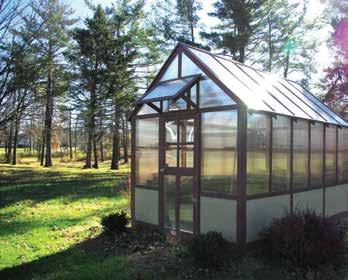
















The Kansas City Gardener | June 2024 7 Dianthus Coronet White Purple Eye Monarda Pocahontas
Rose
Red
Chrysanthemum Igloo Cool
Veronica Aztec Gold
Lewisia
Elise Gold
Dianthus Rock Ruby
Nepeta Limelight
Aquilegia Kirigami Rose and Pink
Discover the Best New Perennials at a great price! Available early to mid-April in most locations. Bellis Bam Bam Red Lily Asiatic Matrix Orange
Mint
Hardy! 3” Blooms! Look for the 4” purple pots at these locations: Rose, Miniature Parade Petula 10 Colors! • Creekside Market • Euston Hardware • Grass Pad • Larry’s Nursery • Louisburg Nursery • Pack’s Hardware • Soil Service • Suburban Lawn & Garden • Water’s Hardware • Westlake ACE Hardware • Plus Other Local, Independent Garden Centers ‘ Western Red Cedar Greenhouses with maintenance-free Azek® exterior Available in several sizes frontierfurnishings.com • 618-465-8868 • 101 W. Third St., Alton, IL 62002 BEAUTIFUL • PRACTICAL • FUNCTIONAL
Delphinium Guardian Blue
Herb
Mojito
Rose Report
Deadheading Instructions by Charlie
It’s June! National Rose Month! June 12 is National Red Rose Day. In Kansas City, June 1 is the annual Rose Show and June 2 is Rose Day when the show will be open to the public and the rose garden will be full of fun family activities. This is the greatest month of the year for rose growers! The spring flush is always amazing, the once-a-year bloomers are still going and the rebloomers are starting. What a wonderful time! How do you keep this time as beautiful as possible? Deadheading, watering, and feeding.
What is “deadheading” and why is it important? There are many articles about deadheading all kinds of flowers, including roses. Here are a few suggestions that I learned from my favorite rosarian Charles Anctil (decd. 2017), as well as a few from my own experiences. So, here goes.
Deadheading is the way you encourage a rose to produce more blooms. It’s just that simple. Since I work in a public rose garden, I like to leave the blooms on the bushes as long as possible for everyone to enjoy. Many times, the aroma of the rose increases as it matures. However, after a while the blooms will start to wilt, drop their petals and some roses even try to create rose hips (the fruit of the rose). That is the time to deadhead. Cutting the older blooms from the bush gives the message to create new growth. The rule of thumb for deadheading a rose is “cut to the first 5-leaf”. While that is a good start, Charlie gave me additional considerations that should also be addressed. They are, the type of rose, the current environment, the health of the bush, and any event that might be coming up. So, first make an overall assessment of each bush in the garden. During the assessment of each bush, try to envision how the bush needs to be pruned to keep it as


This easy-to-follow pruning graphic is from the Gardening Class Facebook page.
beautiful as possible. Is it growing too dense in the center? Are the blooms too heavy for the stems they are growing on? Are there signs of disease? Is there an event occurring soon when you want to have the bush at its prime? All these questions will give you a better road map of what to do when deadheading. Included below is a graphic of how to cut when deadheading. It is very good and easy to understand. Look it over carefully and cut accordingly. So, remember the “5leaf” directive, but make changes according to the other factors.
The following are some of Charlie’s thoughts when deadheading. If the stem is too weak to hold up a healthy bloom, look further down the stem to find a place to cut, and if the stem is thin all the way to the next junction, cut that stem off completely to let stronger stems grow. If the bud is facing inward, go down farther on the stem and find a
CORINDA STALLBAUMER
Consulting Rosarian

bud facing outward. If the next event in the garden is scheduled soon, cutting higher on the stem will allow the new bloom to appear sooner. Cutting deeper down the stems will take the rose longer to bloom. However, no matter how you plan, remember that temperature and weather conditions can make significant differences. The higher the temperature the faster the bloom will bloom out; lower temperature or clouds will lengthen the time the bloom will stay.
Included below are links to information about deadheading. The videos on the Kansas City Rose Society website are excellent with specific videos for different types of roses. Kansas City rosarians are willing to display their methods at the Laura Conyers Smith Rose Garden in Loose Park. Contact them to make an appointment. I live in St. Joseph, Missouri, and tend the public rose garden at the
Wyeth-Tootle Mansion which is associated with St. Joseph Museums. To make an appointment please call The St. Joseph Museums and leave your contact information so we can schedule a visit. Another resource in St. Joseph is Moffet Nursery.
Suggested Links:
• Kansas City Rose Society https://www.kansascityrosesociety.org; Select “Rose Info” then “Deadheading Roses”
• American Rose Society website https://www.rose.org; Select “Education” search “Deadheading”
• Laura Conyers Smith Municipal Rose Garden https://www. kcrsroselibrary.com
• For help with specific questions contact kcrosehelp@gmail.com.
Corinda Stallbaumer is an American Rose Society Consulting Rosarian and a Buchanan County Missouri Master Gardener. A native of Kansas City and a graduate of KU, she tends the memorial rose garden at the Wyeth-Tottle Mansion in St. Joseph. Her philosophy is the same for roses as it was for her career in information systems; never stop learning!
by Corinda
8 June 2024 | kcgmag.com
Wyeth-Tootle Mansion Memorial Rose Garden in spring.
Photo
Stallbaumer.


Leavenworth County Historical Society
GARDEN TOUR
Saturday, June 15 10am – 4pm
• Tour 5 unique backyard gardens

• The Victorian Herb & Heirloom Garden at Carroll Mansion Museum
• The Suburban Restaurant Patio & Garden (10% discount for Garden Tour ticket holders, 6/15/24)
Ticket donation $20.00 at Carroll Mansion Museum 1128 5th Ave. Leavenworth, Kansas (913) 682-7759
Candle Queen Candles www.LeavenworthHistory.org

Missouri Wildflowers Nursery
573-496-3492, fax: 573-496-3003 www.mowildflowers.net mowldflrs@socket.net 9814 Pleasant Hill Rd Jefferson City MO 65109
We’ll be in the KC area in the fall. Watch for our ads here in August & September.
Shopping at our Brazito (Jeffeson City) store: Visit our home location any of the times listed below. You can also place an order and pick it up at the nursery. Hours:
Weekdays: Year-Round: 9 AM - 5 PM
Weekends: March 16 - July 7 & August 31 - October 13
Saturdays: 9 AM - 5 PM, Sundays: Noon - 5 PM
We can ship your order! We ship plants on Mondays, Tuesdays and Wednesdays all year. UPS usually delivers the next day to Missouri and the surrounding states. Shipping charges apply.

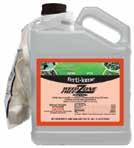






The Kansas City Gardener | June 2024 9 Mowing • Trimming Planting • Mulching Seeding • Aeration Fertilization • Clean Up Barclay Berberian 913-208-5941 LawnsByBarclay.com NOW AVAILABLE AT: Jacksons Greenhouse & Garden Center, Topeka v Doctors At the Lake, Lake of the Ozarks v Manns Lawn & Landscape, St. Joe v Gronis Hardware and Seed, Leavenworth v Clinton Parkway Nursery, Lawrence v Barnes Greenhouses, Trenton, MO v Soil Service Gdn. Center, Kansas City, MO v Loma Vista North, Kansas City, MO v Skinner Garden Store, Topeka v Full Features Nursery, Smithville v Springtime Garden Center, Lee’s Summit v Heartland Nursery, Kansas City, MO v Planter’s Seed, Kansas City, MO v Penrod’s Greenhouse, Kearney v North Star Garden Center, Liberty v Grimm’s Gardens, Atchison v Moffet Nursery, St. Joe v Suburban Lawn & Garden, Kansas City, MO Rid Your Lawn OF WEEDS with ferti•lome RAPID WEED CONTROL Works in as little as 24 hours. Dries in 3 hours & is reseedable in 3 weeks. Great for harder to kill weeds like henbit, clover, thistle, dandelions, wild violet & many more.This is the BEST weed killer available and IT WON’T DAMAGE YOUR LAWN! www.fertilome.com WEED FREE ZONE New size! 1 gal. ready to use BFG is the Leader in Green Industry Distribution 816-842-5012 • pondskc.com 1557 Swift Ave., KCMO Come see us first for your pond liner needs. Great prices for both hobbyists and installers. THE METRO’S EXCLUSIVE POND RETAILER See our Facebook page for current hours. Friendly personable knowledgeable service! ALL BULK LINER ON SALE 45 MIL EPDM AND 40 MIL PVC! ALL BOXED LINER ON SALE!
for all your water garden needs!
Fish and Pond Supplies
By June, the frantic rush of migration is past. Most of our breeding birds have established territories, won their chosen mates (using songs, flight displays, and that foolproof standby, food), and settled down to nesting. Some especially prolific songbirds, such as Eastern Bluebirds and House Finches, have already launched at least one family and are tending additional broods. (Bluebirds in Missouri may nest THREE times between March and July!) Birds of prey (hawks and owls) continue their lengthy nesting process begun in late winter and early spring. Their eggs require long incubation periods—4 to 5 weeks on average, compared to about 2 weeks for most songbirds. Their offspring spend 4 to 6 weeks in the nest and then rely on parental feeding for as long as several months afterwards, while they master flying and hunting skills. In contrast, most songbirds fledge (leave the nest) at just 2 to 3 weeks of age! This reduces their chances of succumbing to predation, while allowing parents to maximize their number of offspring. Even in ideal habitat, many nests fail and up to 70% of young birds don’t survive their first year, so large numbers of eggs and babies are vital to sustaining bird populations.
Nature-friendly landscaping, using a variety of native plants and providing amenities like water features, brush piles, and nest boxes, creates wonderful opportunities to observe and enjoy breeding birds. Consider these tips to help birds nest successfully.
Nest Boxes: Nest boxes require proper placement and a commitment to maintenance. Choose (or build) only boxes that allow access for cleaning! Fixtures should be easy to operate and close securely. Horizontal grooves beneath the entrance hole create a “ladder” allowing fledglings to exit more easily. Ideal dimensions for entrance holes and floor space vary by spe-

Nesting Knowledge

cies; learn which birds may nest on your property and choose boxes accordingly. Consider installing open nesting “shelves” in protected areas to attract robins, doves, swallows, and phoebes.
Boxes should be ready for occupancy by early March. Mounting them on poles, not trees or fences, may decrease ant infestations and predation. Baffles may be necessary to deter snakes. A light coating of unscented bar soap (such as Ivory) on interior walls and roofs of nest boxes helps prevent wasps and bees from appropriating them. Clean and repair boxes in September or October, removing nest material from the immediate area to discourage predators. If boxes remain available for winter shelter, clean again in spring.
Nest Materials: Spider webs, moss, lichens, twigs, and grasses in gardens are all used for construction and concealment. An area of bare soil, moistened regularly, provides mud for robin and swallow nests. Birds appreciate supplemental nest-lining items, such as pet hair, feathers, pine straw, and plant material (thistle down, cattail fluff,

Black-capped Chickadees love nest boxes.
etc.), which can be offered in a suet holder. Animal hair should be free of insecticidal residues (flea/tick treatments). Birding stores supply sheep’s wool and alpaca hair. Avoid using yarn or dryer lint that may entangle birds.
Nest Observation: Watching nests is fascinating, but birds’ welfare should be paramount. Keep your distance, use binoculars, and supervise pets and children so birds can build nests, incubate eggs, and feed young unmolested. Excessive disturbance near nests attracts predators and may inspire nest abandonment, or premature fledging. Don’t
disturb vegetation or nest contents for viewing or photography. Limit nest monitoring visits to once every 3 or 4 days.
Birds are masters of concealment, and many nests are unintentionally destroyed by human activities. Inspect trees and shrubs (especially cavities possibly harboring owls or woodpeckers) before cutting them down or pruning. Survey grassy areas for ground nests before mowing. Watch for nests inside sheds and barns to avoid entrapping birds. Dryer vents and chimneys should be covered to prevent nesting attempts in these unsuitable locations.
Wrens and House Finches are notorious for nesting in pots, wreaths, and hanging baskets, seemingly oblivious to humans. They’re usually successful if watering is performed sparingly and plants aren’t moved. They may return to the same nest site repeatedly.
I found a baby bird—now what? Remember that youngsters often fledge before they can fly, but are usually NOT abandoned! Fully feathered, healthy looking chicks should be left alone, so parents can care for them. Low, dense shrubs protect parents and chicks.
Very young babies (naked or partially feathered) should be placed in a paper towel-lined container (whipped topping cartons work well). Secure the container above ground level near their original location and watch for the parents’ return. For assistance with injured or orphaned birds, contact Lakeside Nature Center (Missouri residents) or Operation Wildlife (Kansas residents).
For more information, please consult Cornell University’s excellent Project NestWatch website (https://nestwatch.org), which explains everything from identifying nests and eggs to maintaining nest boxes and submitting citizen science observations.
Happy Nest Watching!
Elizabeth Stoakes is currently President of Burroughs Audubon Society in Kansas City and has been birding for over 25 years. Please contact BAS via mail@burroughs.org or text/call 816-795-8177 with any birding questions.
10 June 2024 | kcgmag.com
ELIZABETH STOAKES Birding Enthusiast
Great Horned Owl fledglings await dinner.
Photo by Terrence Thompson.
Photo by Jill Bell.

















The Greater Kansas City Water Garden Society Presents Wings Over Water Gardens 31st Anniversary Tour
The 2024 Season of Tours are on the following Saturdays from 9 a.m. to 5 p.m. — Rain or Shine
BLUE SPRINGS
Westlake, 1205 N 7 HWY
BONNER SPRINGS
Westlake, 626 S 130th St
FAIRWAY
Hen House, 2724 W 53rd St
GLADSTONE
Westlake, 5945 NE Antioch Rd
KANSAS CITY, KS
Hen House, 8120 Parallel Pkwy
KANSAS CITY, MO
Planter’s Seed Company, 513 E Walnut
Soil Service Garden Center, 7130 Troost
Suburban Lawn & Garden, 4 W 135th St
Sutherlands, 311 W 72nd St
Westlake, 1000 Westport Rd
Westlake, 5009 NE Vivion Rd
Westlake, 104 W 63rd St
Westlake, 9715 N Ash Ave
LEAVENWORTH
Westlake, 3400 S 4th St Trafficway A
LEAWOOD Hen House, 11721 Roe Ave
LEE’S SUMMIT
Randy’s Lakeview Nursery, 1820 NE County Park Rd
Westlake, 103 S M-291 Hwy
Westlake, 444 SW Ward Rd
Westlake, 3511 SW Market St
LENEXA
Hen House, 15000 W 87th Pkwy
Suburban Lawn & Garden, 9275 Dunraven St Westlake, 15225 W 87th Pkwy




Westlake, 10080 Chestnut St LIBERTY Family Tree Nursery, 830 W Liberty
LOUISBURG Swan’s Water Gardens, 4385 W 247th St N KANSAS CITY, MO
KC Pond, 1557 Swift
OLATHE
Hen House, 13600 Blackbob Rd
Sutherlands, 16665 W 151st St
Westlake, 120 N. Clairborne
Westlake, 1185 W Santa Fe
OVERLAND PARK Family Tree Nursery, 8424 Farley
The Kansas City Gardener | June 2024 11
Hen House, 11930 College Blvd Hen House, 6900 W 135th St Suburban Lawn & Garden, 10501 Roe Ave Westlake, 9301 Santa Fe Dr Westlake, 11200 Antioch Rd PARKVILLE Westlake, 9200 NW Highway 45 PRAIRIE VILLAGE Hen House, 4050 W 83rd St Hen House, 6950 Mission Ln Westlake, 4049 Somerset SHAWNEE Earl May Garden Center, 21700 Midland Dr Family Tree Nursery, 7036 Nieman Rd Westlake, 12230 W 63rd St SMITHVILLE Pack’s Hardware, 116 N US Hwy 169 GET YOUR TICKETS AT THESE RETAILERS BEGINNING JUNE 1ST. July 13 Tour #1, Kansas North Aug 3 Tour #3, Kansas South July 20 Tour #2, Missouri South Aug 10 Tour #4, Missouri North Updated NTDF Logos as of March 2023: If you need EPS (Encapsulated Postscript) versions, please contact NTDF@kcmo.org or 816-513-3214 Full Color Primary Full Color Reverse Black and White Black and White Reverse Tickets for all 4 tours are $10. Good for all tour dates and locations. Children under 14 attend free. Purchase tickets through Eventbrite by scanning the QR code, or visit kcwatergardens.com/2024-tour. 2024 Tour Eventbrite Ticket *Proof of ticket gives free admission on any of the 4 tour dates at the Kansas City Zoo. Present a FreshFront Landscape CALL NOW SCHEDULE to (816) 916-5171 112 E Green St • Clinton, MO 64735 • 660-885-3441 • Mon-Fri 8-6, Sat 8-4 Annuals & Perennials Clematis & Natives Proven Winner Plants Garden décor pottery, statuary and planters Nice selection of Roses, and Flowering shrubs A Gardener’s Destination Top Soil • Mulch • River Rock • Sand • Gravel Fireplace Materials • New & Used Brick • Pavers 9108 W. 57th Merriam, KS 66203 (1 blk E. of Merriam Dr.) Hrs: Mon.–Fri. 7am–4:30pm • Sat. 8am–12pm 913-432-8092 Design/Build • LED Lighting Pond Cleaning Services • Maintenence Repair - Leak Diagnosis • Winterization 816-560-0816 LoyalPond.com LoyalPond@gmail.com Our passion is water and providing an enjoyable outdoor oasis for our customers. TELL ADVERTISERS YOU SAW THEIR AD IN THE KANSAS CITY GARDENER. SUPPORT LOCAL KCGMAG.COM
GREAT FOUNDATIONS
How to Pick the
Perfect Flowering
Shrubs to beat the summer heat
Are y’all melting yet? Summer heat and humidity do give us the vapors. We watch in agony as our precious plants droop in drought, mortgaging our souls to pay the water bill to keep them happy. But there are better options. For fabulous color and multi-season interest, many shrubs will tolerate high heat, drought, and wacky soil conditions.
Choosing Foundation Plants
Before you dig your first hole, consider some design basics. Foundation plants do more than add color and interest to your house’s exterior. They reflect your personal taste and enhance or mirror the home’s architectural style. A good foundation planting provides a finished, polished look and creates a welcoming vibe. But most of all, it should reflect your personality and bring you joy.
Consider the Architectural Style
When creating a foundation planting, consider the architectural style of your house. Is it formal or casual? Is it a new construction, or has it sheltered generations of families? Based on your home’s style, you’ll want to design a foundation planting that accentuates it.
Choose Your Colors
Along with the style of your home, its color also plays a part in choosing your foundation plants. Whether you prefer complementary or contrasting colors, it’s a good idea to limit the number of flower colors so the planting doesn’t look too busy. Pick your favorite color scheme, then repeat it in different forms and sizes.
Plan for Growth
Remember, your new foundation shrubs will grow. Space the plants according to their mature size, which you’ll find online or on the plant tags. Leave enough room between plants to ensure they’ll grow well without crowding. A little homework now saves headaches later.
Create Layers
For a multidimensional foundation planting, think in layers. Place larger shrubs closest to the foundation, then work outwards, adding medi-

um-sized plants next and low-growing shrubs near the front. A well-designed foundation planting keeps the garden show going all year long.
Pick Your Plants
To help get you started, we’ve selected some of our favorite flowering shrubs to make your southern foundation planting shine.
Front of the Bed
Ground Hug® Aronia Chokeberry
If you’d rather not spend all of your free time weeding, Ground Hug® Aronia quickly covers the ground, leaving little room for weeds to sprout. Clusters of white blooms in the spring attract pollinators, while the black-purple berries add interest in summer. As if it hasn’t already earned its keep, Ground Hug® lights up your foundation in autumn with gorgeous red-orange foliage.
Light: Full sun, part-sun
Size: 8-14’ tall, 3’ wide
Soil: Tolerates a wide range of soil pH, wet or dry soil
Water: Average; drought tolerant once established Zone: 3-9
Lo & Behold® Series Buddleia Butterfly Bush
Butterfly bush often gets a bad rap: in some areas, it spreads like wildfire. Although these beautiful blooms feed pollinators, gardeners get testy about buddleia appearing where they didn’t plant it. We get it. That’s why there’s the Lo & Behold® series: a compact series of butterfly bushes that look lovely, feed pollinators, and don’t invade your space. Deer resistant.
Light: Full sun
Size: Varies, 1.5-2.5’ to 3’ tall/wide
Soil: Well-draining; dislikes overly wet, soggy soil
Water: Very drought tolerant once established Zone: 5-9
Beyond Midnight® Caryopteris Bluebeard
When summer heat makes your garden look limp and lethargic, Beyond Midnight® Caryopteris bursts into bloom. This late-sum-
JULIE THOMPSON-ADOLF Garden Writer
mer bloomer gives pollinators and your garden a great refresh, flowering profusely when many plants whimper, “Uncle!” Deep, glossy-green foliage is topped with rich, brilliant blue flowers. Deer resistant.
Light: Full sun
Size: 2-2.5’ tall, 2-2.5’ wide
Soil: Well-drained, dry
Water: Drought-tolerant once established Zone: 5-9
Back of the Bed
Sugar Shack® Cephalanthus Buttonbush
Sugar Shack® Cephalanthus works beautifully in both formal and cottage-style foundation plantings. A cultivar of the North American native buttonbush, Sugar Shack® sports all of the plant’s great benefits—but in a beautiful, compact form. The prolific, fragrant white flowers support pollinators, and the red fall berries add autumn interest—and feed wildlife. Deer resistant.
Light: Full sun, part-sun
Size: 4-5’ tall, 4-5’ wide
Soil: Tolerates alkaline, clay, wet, and dry soil
Water: Average; grows well even in boggy conditions Zone: 4-10
El Niño™ Chitalpa Desert Orchid
You’ll sing the praises of El Niño™ Chitalpa when you add it to your foundation planting. After all, who doesn’t adore fragrant, orchid-like blooms minus prima donna tendencies? A hybrid resulting from two North American native plants—desert willow (Chilopsis linearis) and catalpa (Catalpa sp.), El Niño boasts its parents’ best traits, with beautiful blooms that withstand harsh conditions and flower for ages.
Light: Full sun, part-sun
Size: 5-8’ tall, 4-6’ wide
Soil: Well-draining; tolerates poor soil
Water: Average Zone: 6-9
So, which is your favorite? Thank goodness you don’t have to pick just one! Choose your favorites, and you’ll enjoy a charming foundation planting that withstands sultry summers.
Julie Thompson-Adolf is a master gardener, garden writer, and author of Starting & Saving Seeds (Cool Springs Press, 2018). She gardens year-round in South Carolina, battling heat, humidity, and voles—but loves every minute of it. She writes for many horticulture clients and publications.
12 June 2024 | kcgmag.com



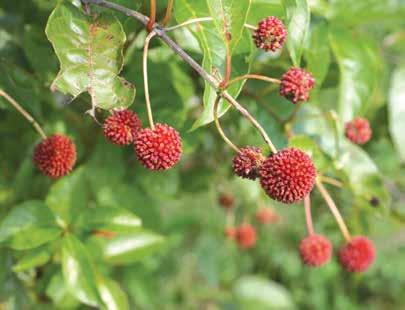
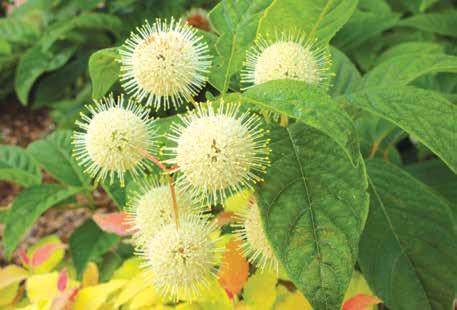



The Kansas City Gardener | June 2024 13
Lo & Behold® Series Buddleia Butterfly Bush
Beyond Midnight® Caryopteris Bluebeard El Niño™ Chitalpa Desert Orchid
Sugar Shack® Cephalanthus Buttonbush fall berries
Sugar Shack® Cephalanthus Buttonbush
Ground Hug® Aronia Chokeberry in spring (left), summer (above) and fall (below)

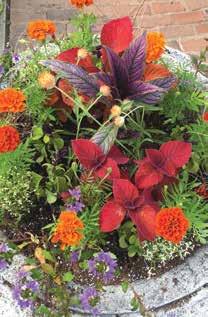


Summer Container Success
Container gardening is the most accessible form of gardening we have. You can have beautiful pots on a small apartment balcony or on a sprawling estate. It can work if you have low light levels or hot blazing summer sun. Here are some how-tos & tips to make your summer containers rock all the way into fall.
I am team “make a plan” before I go shopping. I start with color, always. I sometimes pick a color that coordinates with the surrounding plants or features. I had an orange front door for a number of years, so I played that up. Or sometimes I just go with a color of a certain plant that is the star of my container. This summer, the pots on the back of the Longhouse Visitor Center at the Overland Park Arboretum & Botanical Gardens are featuring Senecio ‘Angelwing’. I saw it and knew that my pots had taken a turn to white and silver.
Consider your light, size of your containers, and how much you realistically want to care for your container. Our Midwest summer sun can be brutal. When they say full sun, they mean unrelenting. Don’t put a plant that says part shade or shade in the full sun. It will fry like bacon!

The size of your container is key and the amount and size of your plants is super important. If you have a small twelve-inch pot for example, maybe three or four plants, depending on their size, is plenty. The plant needs room to grow. I follow a few custom container companies on social media. They do beautiful things, but most of the time their creations are packed to the gills. There is absolutely no room. Leave your plants space to grow and fill in.
That will also help answer the question…Really, how much time am I going to care for this? If you pack it full in early summer, you may be watering it every five minutes at the end of summer. I water my containers on a schedule, every other day. At the Overland Park Arboretum & Botanical Gardens, we water Monday, Wednesday and Friday. At the beginning of the season after you plant, you have got to give them some tough love. They need to push roots down; water deeply until water drains out the bottom. Some days they may wilt a little. Give them a pep talk and stay on your schedule.
I am a very low maintenance gardener, but I give my pots a little extra love by mixing in a slow
ANNE WILDEBOOR Horticulturist
release fertilizer called Osmocote when I plant. You do need to be careful to mix it well with your soil. I also do a light top dress. Just be careful not to put big piles that can burn the plants. I use a peat-based soil mix for my containers, Pro Mix, Miracle Grow, whatever you prefer. Just no topsoil, it’s way too heavy.
There was an author that promoted “Thrillers, fillers & spillers”. This is an easy way to consider how to arrange or plan your containers. But don’t feel like your pots won’t be beautiful if you don’t “follow” that recipe. If monoculture or one plant works for you, go for it.
There are endless possibilities of fun plants. Here are some of my favorites. For sun, Angelonia, Coleus, Salvia, Gomphrena, Lantana, Marigold, Zinnia, and Verbena. With each of these plants you need to be mindful of the size you are selecting. Most of them come in varying sizes, small to medium to large and in charge. They also come in multiple color options so if one of them is successful for you, you can try a different color next year with hopefully the same fantastic results.
My shady/part shade favorites are Caladium, Coleus, Sunpatiens,
ferns, Torenia, Glimmer Impatiens, tuberous and rex Begonias. Brightening up those shady spots is paramount when selecting your plants. Look for bright vibrant colors — black or dark flowers are probably not the best in the shade.
Texture is an undervalued component when it comes to planning your containers. Texture gives your pots a little movement so the eye stops instead of moving past. Here are some of my all-time favorites: Euphorbia Diamond Frost. All of them in the series are great, but Diamond Frost adds the perfect amount of sparkle. Alternanthera ‘Red Threads’ is a great size, the burgundy foliage goes wonderfully with every color. Don’t forget about grasses, which are easy and give lots of movement. They also are great into the fall months; throw some mums in with those grasses and you’re set. Celosia is another fantastic summer choice that does wonderful in the fall. Tropicals are another avenue of texture fun! Bottom line is to have fun, try new things. Do what works for you. If you want to throw some herbs in there so you can make pesto, do it! Pair colors that accent each other. Happy planting! I hope you have great containers in 2024!
Anne Wildeboor, a Kansas State University graduate in Agriculture/Horticulture, has over 20 years of experience in public horticulture, including roles at Powell Gardens and the Overland Park Arboretum & Botanical Gardens. She loves sharing her passion for plants with the public and working alongside dedicated staff and volunteers.
14 June 2024 | kcgmag.com














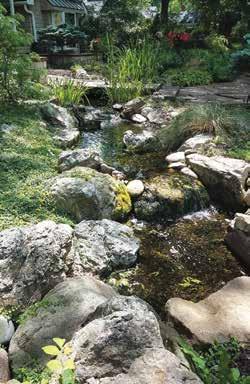


The Kansas City Gardener | June 2024 15 LAKEVIEW NURSERY & STONE WE DELIVER! CALL TODAY! 816.525.1111 WWW.LAKEVIEWKC.COM 1820 NE COUNTY PARK RD, LEE’S SUMMIT SOIL • SAND • GRAVEL • MULCH • DECORATIVE STONE • FLAGSTONE • BOULDERS • PAVERS & WALLS Koi Pond and Water Feature Designs Wendy Hix • 913.481.5416 Tate Foster • 913.406.6804 www.hixandsonaquatics.com New Installations, Remodels Upgrades, Repairs and Maintenance Services Mowers, Blowers, Hedge Clippers and Chain Saws are in stock now! All equipment assembled, serviced and ready to go when you buy it. We also carry Lawn & Garden supplies, pet supplies and bird seed. We service what we sell and more! Nothing goes out of here in a box! 4807 N. Brighton, KCMO www.mowerpartskc.com 816-452-8393 Mon.-Fri. 9a-6p • Sat. 9a-1p (closed for lunch 12:45-1:30) Loyalty Program Buy 9 bags of seed & the 10th is FREE! Best Selection Of birding supplies in town! Check Us Out on Facebook & Instagram! Enjoying Nature from the comfort of home! 56 NE Sycamore Street, Lee’s Summit, MO • (816) 272-5878
Locally owned & operated by Drew & Megan Diekmann

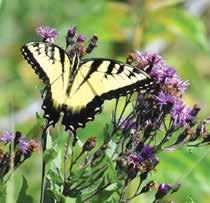
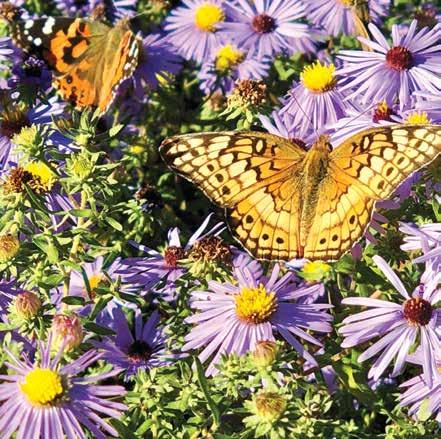
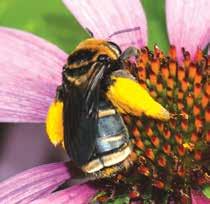

Invitation to Wonders of Discovery Celebration of National Pollinator Week
Friday, June 21, 2024
If you love gardening and nature, please join us for a celebration of National Pollinator Week with the Wonders of Discovery event at the Pollinator Prairie at 320 South Blake Street near downtown Olathe. Visitors will be greeted with beautiful gardens of blooming native plants loaded with busy pollinators.
Wonders of Discovery is a free public event for all ages hosted annually by the Johnson County K-State Research and Extension Master Naturalists. It will take place from 9 a.m. until 2 p.m. on Friday, June 21, 2024. There will be many exhibits on Kansas native plants, pollinators, and wildlife. Games and activities are planned for children, so this will be a fun and educational event for the whole family.

National Pollinator Week is celebrated because of the importance of pollinators to our food chain. A pollinator is any type of insect or bird that transfers pollen from one flower to another, helping those plants produce seeds, young plants, and fruit. Pollinators include bees, butterflies, moths, wasps, flies, birds, and bats. Without pollinators, we would not have many of our favorite fruits and vegetables.
One of the pollinators we are proud to host at the Pollinator Prairie is the native bee. Did you know that bees are the most important group of pollinators? In fact, bees are responsible for pollination of approximately 80% of the flowering plants worldwide. Native bee surveys were conducted by scientists in 2022 and 2023 at the Pollinator Prairie. The researchers found
36 native species at this location, with five of the native bee species not previously recorded in Kansas. The bees found at the site were reflective of those seen in a tall grass prairie in Kansas.
Contrary to common belief, bees are not flying around looking for people and pets to sting. They are very focused on collecting pollen and nectar to feed themselves and their young. You can safely get within inches of bees visiting flowers and not get stung.
If you are hoping to attract pollinators to your garden, you will see many examples of native plants at the Pollinator Prairie. The seasonal gardens at this site provide a wondrous showcase of native plants to meet the needs of pollinators. The more diversity you have in your garden in terms of shapes, colors,
and bloom time of native plants, the better your chances of attracting pollinators to your garden. These native plant species produce the right pollen and nectar at the right time of year for pollinators.
The Pollinator Prairie is free and open to the public from sunrise to sunset every day of the year. An accessible trail winds around four gardens including the Bird Garden, the Bee Garden, the Butterfly Garden, and the Monarch Garden. Each garden is filled with native plants particularly attractive to each species.
For more information on the Wonders of Discovery Event or the Pollinator Prairie, visit johnson.k-state.edu. You can also call the Johnson County K-State Research Extension office at 913715-7000.
Ann Tanner is a pharmacist by training and a naturalist at heart. She is originally from Mississippi, but she has lived in Kansas for more than 30 years. Ann’s passions are conservation, birding, and native prairie protection and restoration. Ann enjoys sharing her knowledge and experience with the community.
16 June 2024 | kcgmag.com
ANN TANNER Master Naturalist
Photo by Betsy Betros.
Colletes inaequalis Unequal Cellophane Bee on Prickly Ash Flower
Svastra obliqua Bee on Purple Coneflower
Variegated Fritillary Butterfly and Painted Lady Butterfly on Aromatic Aster
Colletes Cellophane Bee on St. Johnswort
Photo by Betsy Betros.
Photo by Betsy Betros.
Photo by Ann Tanner.
Eastern Tiger Swallowtail Butterfly on Ironweed
Photo by Ann Tanner.
Design, Installation and Maintenance Services From













Grow Naturally For Healthier Soil & Plants
EARTH RIGHT products help you beat the heat. Our conditioner is in all of the plant products. This helps wick water, keeping plants cooler. For bigger roots & lots of blooms use Mushroom Stuff™ & Sure Bloom™ on turf or in gardens. Keeps roots from burning & soil conditioned. Great





Products for the health & beauty of your lawn & garden.® Contact Tobin Lawn 816-765-5565, or Big Green Turf Management (816) 600-4936 to have our products applied for you. Visit the Laura Conyers Smith Rose Garden & see Earth Right products at work!




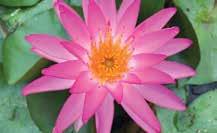
The Kansas City Gardener | June 2024 17 Biggest Aquatic Plant Selection in the Kansas City Area 913-837-3510 Office and Retail Hours Tues-Saturday 9am to 4pm 4385 W. 247TH ST., LOUISBURG, KS 66053 WWW.SWANSWATERGARDENS.COM SERVICES • KOI POND AND WATER FEATURE INSTALLATION • SERVICE CALLS: LEAK DIAGNOSIS, LIGHTING, PUMP AND AERATION INSTALL • LANDSCAPE LIGHTING: AMP LIFETIME FIXTURES AND TRANSFORMERS • HARDSCAPES: PATIOS, WALLS, FIREPITS, DECKS, AND OUTDOOR LIVING • CLEANOUT AND MAINTENANCE PROGRAMS • LARGE POND AND LAKE MANAGEMENT PLEASE CALL TO CONFIRM PLANT AND FISH AVAILABILITY Stop in and Shop our Organic Greenhouse! • Annual & Perennials • Vegetable & Herbs • Shrubs & trees • House plants • Gardening products
Missouri organic produce coming soon! 436 W. 85th St., Kansas City, MO 816-444-7661 waldogreenhousekc@gmail.com facebook.com/waldogreenhousekc Often Copied NEVER DUPLICATED Accept only Earth Right
•
Covers 20K sq ft. Covers 10K sq ft. Natural products that work!
in containers!
www.superlawnstuff.com (913) 492-2992 Made in the Heartland Planters Seed Co. • Since 1924 • Retail • Wholesale Lawn • Garden • Farm 513 Walnut, KCMO • 816-842-3651 Mon-Sat 8am-5pm, Sun 9am-3pm June Planting Dates Plant Above-Ground Crops: 8, 9, 15-19 • Plant Root Crops: 22, 23, 27 Transplant: 15-19 • Plant Flowers: 8, 9 • Control Plant Pests: 1, 2, 5, 6, 29, 30 Grass Seeds • Fertilizers • Mulches • Bulbs • Bird Supplies • Pottery Best Quality of “Locally Grown” Bird Seed! Flowers & Vegetable Seed ~ Largest Selection in the Area Large selection of wind chimes, gnomes, toads and garden art décor. 7130 Troost, Kansas City, Mo. www.soilservice.com 816-444-3403 Landscape
trees
shrubs to perennials, mulch
stone, expert
are ready to help with
next project!
for
At-Home Consultation. Celebrating 90 years!
and
and
Landscape Designers
your
Call
an

 Photos by Lenora Larson.
Photos by Lenora Larson.
2 3 4 5



Butterflies: Males or Females, Can You Tell?
Humans care immensely about gender because its importance transcends reproduction. Even before the baby is born, we want to know, “boy or girl?” Stereotypes about dress, behavior, career choice and relationship roles influence us the rest of our lives. Our gender curiosity extends to other animals, including bees and butterflies.
Bees: Power of the Sisterhood
You are safe in assuming that any bee, wasp or hornet that you see is a female because the males die almost immediately after mating. Social species like honey bees, bumble bees or paper wasps, live in a community hive or nest ruled by a queen. She is the only reproductive female, the mother of all that hive’s residents and is cared for by her daughters, the workers. In addition to housekeeping and guard duties, female worker bees gather nectar and pollen to feed the queen’s children. In fall the queen lays a brood that includes both males and females, which mate almost immediately after emerging from their pupae. The males die and the now-fertile new queen lives through the winter to continue the female dynasty.
Native bees are solitary species without a queen. Once mated,

the males die and female bees (and wasps and hornets) are on their own as hard-working single mothers without community support systems like hive-sisters. They each build a nest, lay eggs, then feed and care for only their own larvae for about six weeks. All members of a particular solitary species emerge simultaneously from their pupae 46 weeks later to mate and re-start the cycle. Bumble bees are the exception because they are our only native social bee with a queen and new female worker bumble bees which are produced throughout the spring and summer.
Caterpillars: The Innocence of Childhood
Mammals are born with obvious gender so butterfly lovers often wonder whether caterpillars emerge from their egg as a boy or girl. Those who raise caterpillars especially want to know which pronoun to use! Genetically, that caterpillar is already a male or female but there are no discernable signs because the genes are not expressed until metamorphosis when the caterpillar transforms into an adult, complete with wings and appropriate genitalia. Call a caterpillar “it” and hold its gender reveal party at the laboratory after its DNA is decoded.
An adult emerges from its chrysalis with one purpose, reproduction. Remember, adult butterflies don’t have a mouth and can’t eat, but they do have a long tongue to sip nectar for moisture and energy. Males also accumulate proteins and carbohydrates from the nectar to add to their spermataphores, packages of sperm, liquid and nutrients to be passed to the female during mating. Each time a female copulates, she also gets a snack. The male does double duty as food-provider and potential father. Butterflies recognize gender primarily by odor with males wearing the perfume. Pheromone pockets can be seen on the males of many species, including the well-known black dots on the hind wings of male Monarchs.
So why do many species of adult butterflies have differently-colored males and females? Surprisingly, these gender-based color differences are rarely related to sexual identity. Instead, they are mimicry to avoid being eaten by birds and other visual hunters. For example, both sexes of the Eastern Tiger Swallowtail usually exhibit wings of bright yellow with black stripes. However, the female occasionally shimmers in blue-black, especially if Pipevine Swallowtails also inhab-
it the area. Pipevine Swallowtails gleam with blue-black wings and rarely are eaten by predators since they are the most poisonous butterfly species in North America. Scientists theorize that the blue-black color on a female Tiger Swallowtail protects her from hungry birds who have learned through experience to never eat a blue-black butterfly. To the great frustration of butterfliers seeking to identify a specimen in their gardens, several other butterfly species have blue-black females and variously colored males. Sorry guys, nature preferentially protects the egg-laying females.
CAPTIONS
1. A female Black Swallowtail mimics the blue-black Pipevine Swallowtail. The male is black and yellow.
2. Both sexes of the Red-spotted Purple butterfly wear the protective shimmer of blue-black.
3. A “dark form” female Tiger Swallowtail is mimicking the Pipevine Swallowtail.
4. Pipevine Swallowtails set the model for other blue and black butterflies because birds rarely eat them.
5. The male Tiger Swallowtail always wears yellow and black.
A Marais des Cygnes Master Gardener, Lenora is a member of the Idalia Butterfly Society and Kansas Native Plant Society. She gardens in the clay soil and cruel winds of Paola, KS. She may be contacted at lenora.longlips@gmail.com.
18 June 2024 | kcgmag.com
LENORA LARSON Butterfly Maven
1
Life
as a Boy or Girl Butterfly










The Kansas City Gardener | June 2024 19 follow us on Facebook 1430 Hwy. 58, LeRoy KS 66857 info@arnoldsgreenhouse.com Sunday 1 - 5 pm (CLOSED June 16 for Father’s Day) It’s a new season with new ownership/managementand a renewed commitment to excellent customer service... Come see what’s blooming at Enright ... We have everything you need from Azaleas to Zinnias. Enright Gardens No Ordinary Gardening Adventure gorgeous plants, wonderful staff, unique garden store www.enrightgardens.com NOW BLOOMING AT THESE 3 LOCATIONS 2351 N. 400 Rd. • Edgerton, KS • Hours: 9am-6pm, Mon.-Sat. • Sun. noon-4pm 2 miles west of Edgerton on Hwy 56 to County Line, 2 miles north 1/2 west Turner Community Gardens • 55th & Klamm Street • Turner, KS Mon.-Sat. 9am-6pm • Sun. noon-4pm KCMO Farmers Market Location • 3rd & Walnut, Saturday only Stall 50 across (west) from the Arabian One free, easy call gets your utility lines marked AND helps protect you from injury and expense. Safe Digging Is No Accident: “Always Call Before You Dig in Kansas” Call 811, 1-800-DIG-SAFE, (800-344-7233) or visit us at www.kansas811.com. Finally! Organic Ingredients that Really Work! For Organic Use OMRI.org Pet Safe When used as directed when used as directed FOR ORGANIC GARDENING Family Owned & Operated • Made in USA www.sierranaturalscience.com *when used as directed. Powerful Pet & People Safe Pesticides & Fungal Controls* Now Available at Suburban Lawn and Garden Green Street Market • Planters Seed Company Ranch Mart Hardware • Larrys Nursery Arnolds Greenhouse • Northland Feed
Days and Days of Daylilies
Many new gardeners do not realize that daylilies really do only bloom for a day. I hear this comment many times and I explain that Hemerocallis, its botanical name, means Beauty for A Day, which applies to each single flower. The good news is that daylilies have the characteristic of succession blooming for a number of weeks, depending on the size of the plant, its bud count, and environmental factors.
When a daylily is hybridized and registered in the American Daylily Society’s national daylily database, its bud count and branching are two of the specifications listed. Older daylilies tended to have fewer than a dozen buds so the bloom time would be 2-3 weeks. Newer daylilies are being developed with bud counts of 2-4 dozen plus, thereby extending bloom time to 4-6 weeks. Each scape of a daylily has numerous buds that will open at different times for over a month. So you may get one bloom one day and multiple blooms on another day. As your plant grows and multiplies over the years, there will be more daylily blooms to enjoy.
Another specification for the plant is the bloom season. The designations are EE, E, EM, M, ML, L, VL. In the Kansas City area an Extra Early will normally bloom in late May, with Early following in early June. The next group of Early Midseason, Midseason and Late Midseason will bloom from the middle of June into July. The Late and Very Lates will be blooming in late July into August. When you purchase daylilies, you can look for the season designation and select plants that will bloom for an extended time, possibly for over three months. I did have a daylily blooming in October one year but that is the exception in my garden. The American Daylily Society database just reached 100,000 registered daylilies. Searching the database, I found 1700 extra early daylil-





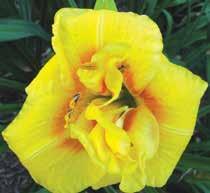
ies, 9184 early, 2675 late and 571 very late registrations. While many of these may no longer be in commerce, you should be able to find a nice variety for your garden. Microclimates will influence bloom times with earlier and later bloom in sheltered city gardens.
When you are selecting daylilies for your garden you may want to select a wide range of colors, shapes, and sizes. The color combinations are endless but there is no pure white or pure blue daylily registered. The shortest I found was a dwarf at 5” and the tallest was 96” so you can plant from the front of your garden to the back fence. The bloom size of the flower can range from a miniature at 1” to 16.5” being the largest spider registered. The shape classifications are single bloom (3 petals and 3 sepals), doubles (twice the number of petals and sepals), spiders (a petal ratio of
4:1 length vs. width) and unusual forms (the flower must have distinctive crispate, cascade or spatulate shapes on all three petals or all three sepals).
National awards are given to recognize daylilies in many different categories. You can find lists of past and current award winners on The American Daylily Society web page daylilies.org. Scroll down the page and click on Individual Awards, then click on Individual Daylily Awards. There is a box for Early Season Bloom and the Eugene S. Foster awards are for late season blooms. You might also be interested in the awards for the best small, double, spider, eyed, extra-large, etc. The Lenington All-American award is for daylilies that perform well throughout the whole country. This website is an excellent resource for learning more about daylilies.
A great mix of early to late, dwarf to tall, miniature to extra large in a wide range of colors make a beautiful daylily garden. The plants are known for their low maintenance, and ability to grow almost anywhere. Buying from local daylily gardens assures you that the plant is acclimated to the Kansas City climate.
The MoKan Daylily Club will hold their annual sale on Saturday, August 17th at the Loose Park Garden Center, 51st & Wornall, KCMO. The sale will be open to the public from 8:30 a.m. to 2:30 p.m. or until sold out. The club will have many varieties for sale and pictures will be available. There will be a Planting Corner to show you how to plant a daylily, and there will be educational handouts on how to care for your new plants. You can follow the club on its Facebook page: Mo-Kan Daylily Society.
Lois Hart has been on the American Daylily Society board directors since 2013. She grows 700 varieties of daylilies in her Miami county gardens and holds an annual open house for visitors to enjoy and learn about daylilies.
20 June 2024 | kcgmag.com
LOIS HART Daylily Enthusiast
Refined by Fire is a very early blooming daylily. Charon the Ferryman is a late unusual form daylily.
Alpenglow Magic is the 100,000th registered daylily
Lava Flow is early blooming. Jelly Filled Donut is an early blooming double daylily.
Photos by Lois Hart.

GARDEN CALENDAR
June list of what to do in the garden.
VEGETABLES AND FRUITS
• Plant squash, cucumbers, sweet corn, green beans, and other summer vegetables.
• Conserve moisture and control weeds with mulch.
• Harvest spring vegetables until the end of the season, then remove.
• Pinch herbs to keep bushy and fresh with new growth.
• Watch for the development of squash bugs as they multiply rapidly—control as needed.
• Treat tomato leaf disease with a fungicide if needed.
• Apply one inch of water per week if there is no rain.
• Continue a regular fruit disease and insect control program.
• Fertilize strawberries regularly to promote new growth.
• Renovate June bearing strawberry beds.
• Treat peach trees for borers.
• Remove sucker growth from the base of trees and along branches.
• Turn the compost pile and keep it moist to hasten breakdown.
FLOWERS
• Pinch chrysanthemum tips for the development of bushier plants.
• Remove spent flower blossoms to keep the plant flowering.
• Remove flower stalks from peonies and irises.
• Fertilize roses and trim spent blossoms.
• Check plants for insects.
• Remove dead foliage from spring bulbs.
• Water and fertilize container plantings regularly to encourage growth and flowering.
• Maintain a 2 to 3-inch mulch layer to reduce moisture loss, control weeds, and preserve excellent soil.
• Apply one inch of water per week if there is no rain.
LAWN
• Mow bluegrass and tall fescue 3 to 3½-inches high to improve drought stress.
• Avoid fertilizing tall fescue and bluegrass during summer.
• Mow Zoysia to a height of 1 to 2 inches all season.
• Fertilize Zoysia with high nitrogen fertilizer such as 27-3-3 one to two more times this summer.
• Repair dead spots and bare areas in Zoysia by sodding or plugging.
• Core aerate Zoysia to control thatch and improve water and nutrient uptake.
• Spot treat for summer broadleaf weeds.
• Fertilize naturally by letting grass clippings fall.
• Water the turf sparingly to increase drought
MY GARDEN (Use this space to list additional tasks to accomplish in your garden.)
•
•
•
•

tolerance during the heat of summer.
• Begin grub treatments with preventive-type insecticides.
• Keep the mower blade sharp for a clean cut.
TREES AND SHRUBS
• Check for bagworms and control.
• Prune elongated “candles” of new growth on pines and spruces to shape/control size.
• Prune spring flowering shrubs.
• Water newly planted trees and shrubs.
• Check for spider mite damage by shaking branches over white paper. Mites look like tiny dots.
• Clip hedges to maintain shape.
• Maintain a mulch ring around young trees and shrubs.
• Prune dead or damaged limbs to correct structure and maintain health.
HOUSEPLANTS
• Water and fertilize regularly to promote summer growth.
• Repot overgrown plants, shifting up to a one-inch larger pot.
• Rotate pots to provide sunlight on all sides, producing a balanced plant.
• Prune and shape plants.
Johnson County K-State Research and Extension recommends environmentally-friendly gardening practices. This starts by identifying and monitoring problems. Cultural practices and controls are the best approach for a healthy garden. If needed, use physical, biological or chemical controls. Always consider the least toxic approach first. Dennis Patton is the horticulture agent for Johnson County K-State Research and Extension. For free information fact sheets, visit www.johnson.ksu.edu, or call the Extension office at 913-715-7000.
The Kansas City Gardener | June 2024 21
Upcoming Garden Events
Leavenworth County Master Gardeners
Wed, Jun 12, 11a; at Riverfront Community Center, 123 Esplanade St, Leavenworth, KS 66048. Leavenworth County Master Gardeners, Mikey Stafford and Anne Reilly, will give a presentation about invasive plants. The program will define what is an invasive plant, identify invasive species and discuss living with (or not) with invasive plants. The meeting is free. Visitors are welcome. For more information contact the Leavenworth County extension office at 913-364-5700.
Leawood Garden Club
Tues, Jun 25, 10:30a; at Cure’ of Ars Catholic Church, 9401 Mission Rd, Leawood, KS 66206. Our speaker will be John ‘Smitty’ Smith speaking on the topic of “Strawberries.” You’ll learn some fun facts and how to harvest the nutritious fruit. Growing strawberries can be fun and is very rewarding. It might even save you some money! Who doesn’t love strawberries? You will learn the unusual fun facts about strawberries, and how to begin your patch at home, and or in your raised bed, maintenance and, most importantly, the harvesting of this wonderful nutritious natural fruit.
MoKan Daylily Club
Sat, Jun 1; at Asbury United Methodist Church, 5400 W 75th St, Prairie Village. The meeting starts at 10:30a with a meet and greet, followed by a pot luck lunch, presentation and short business meeting. The guest speaker is Betsy Betros, who will be speaking to the club about spiders in the garden. Guests are welcome to attend. Questions about the club or June 1 meeting can be emailed to MoKanDaylilySocietyADSR11@gmail.com.
Orchid Society of Greater Kansas City Sun, Jun 9, 1:30p; at Merriam Community Center, 6040 Slater St, Merriam, KS. Beginner’s group 1:30-2p and Featured Speaker at 3p. Dr. Douglas Needham, Oklahoma State University, “Orchid Care in the Home.” Open to the public. www.osgkc.org and find us on Facebook.
Olathe Garden & Civic Club
Tues, Jun 18, 1-2:30p; at Johnson County Extension Office, Room 1070, 11811 S Sunset Dr, Olathe, KS 66061. *Free to attend and open to the public, club membership not required* Please join us for our monthly club meeting and presentation about Victory Gardens from Master Gardener Aleen Van Bebber.
Downtown KCK Farmers Market
Saturdays June thru Oct.; 8a-12pm; at 501 Minnesota Ave, Kansas City, KS 66101.
Native Plant Sale
Sat, Jun 1, 9:30a-2:30p (while supplies last); at Douglas County Fairgrounds, 2110 Harper, Lawrence, KS 66046. Hosted by Douglas Co Extension Master Gardeners. Preorder Bloom Boxes by May 25 for pick up day of sale. Or purchase individual plants day of sale. All plants are grown locally without pesticides, 13 new varieties.
Heartland Hosta & Shade Plant Society
Annual Spring Plant Sale
Sat, Jun 1, 9a-2p; at Woods Chapel Community of Christ Church, 500 NE Woods Chapel
Rd, Lee’s Summit, MO 64064. The sale features over 1200 plants including 68 varieties of Hosta and plenty of shade/part shade perennials! Prices start at $10 and we have all sizes of Hosta from mini to giant to suit all size gardens. This sale is open to the public. Sale list with pictures & descriptions will be available on the club web site prior to the sale. For more information please visit www.HeartlandHosta. club or the Facebook page www.Facebook. com/HeartlandHostaandShadePlantSociety/.
Kansas City Rose Show
Sat, Jun 1; at the Loose Park Garden Center, 51st St and Wornall Rd, Kansas City, MO. As usual, the show is free and open to all rose growers with assistance provided for first time exhibitors. There will be Classes for live blooms and rose photographs. Entries will be accepted from 8-11a. Visit www.kansascityrosesociety.org for the Show handbook with Class lists and Show rules. Also find links to tips on how to grow and show prize-winning roses there.
Kansas City Rose Society Rose Day Sun, Jun 2, 1-5pm in the Loose Park Rose Garden. You can view the results of the Rose Show with hundreds of blue ribbons winners and beautiful silver trophies in the Garden Center. In the Rose Garden you can enjoy many family activities, live entertainment, and an afternoon of beauty in this world-renowned rose garden.
The Union Hill 29th Annual Garden Tour Sun, Jun 2, 10a-3p; at 31st and Grand, Union Hill Neighborhood, Kansas City, MO 64108. The tour begins downtown at 31st and Grand then follows a walking path through this charming, historic neighborhood. Attendees will receive a map and guide to the gardens on the tour. There will also be live music, two food trucks, two lectures by Master Gardener Virginia Murray, as well as an activity map for the young and young of heart. Extension Master Gardeners will be at 3005 DeGroff Way to answer gardening questions and share information about Master Gardeners of Greater Kansas City. Tickets may be purchased on the day of the tour for $15. Advance purchase tickets are just $10 through the Union Hill Garden Tour Facebook page: @UnionHillGardenTour or by visiting unionhillkc.com. All proceeds help with restoration of Union Hill Cemetery and to beautify the public spaces in the neighborhood.
KC Cactus & Succulent Society Annual Plant Sale
Sat, Jun 15; 10a-4p; the Trailside Center, 9901 Holmes, Kansas City, MO. It’s our annual plant sale. Here’s your opportunity to purchase your summer succulents and cactus plants from both club members and professional vendors. New, beautiful pottery, too. The sale is open to the public.
Lee’s Summit Pollinator Festival Sat, Jun 15, 10a-3p; at Lowenstein Park, 1901 Northwest Lowenstein Dr, Lee’s Summit, MO 64081. In honor of Pollinator Week, The Cultural Arts Division of The City of Lee’s Summit is hosting an event to celebrate bees, bats, and other pollinators. Master Gardeners of Greater Kansas City Children’s Programs will be presenting “Pollinators: Not Just Bees and Butterflies.” There will also be Extension Master Gardeners available with information and resources on attracting and supporting pollinators in the home landscape setting. Free to the public, family friendly.
Leavenworth County Historical Society Garden Tour Sat, Jun 15, 10a-4p. Tickets $20. www.leavenworthhistory.org; 913-682-7759
B & F Railroad and Flower Tour Sat, Jun 22, 9a-5p; at 1503 Ensley Cir, Raymore, MO. The entire yard is full of beautiful flowers and we have 6 Garden Trains that run in the entire back yard. This is one of the best Flower Gardens that you will ever see. This is a Free Event. No Pets Please.
Holt County Garden Tour in Mound City MO
Sat, Jun 22 (rain date June 23), 10a-3p. Six “Hidden Gardens of Loess Bluffs” Presented by MO Extension. Six uniquely different flower, vegetable and pastoral gardens. Gardeners, Naturalists, Extension Specialists and Conservation Department Reps will be present in the gardens to offer the opportunity to learn more about pond management, pest control, care for grapevines, tai chi in the garden, native plants and pollinators, chicken runs in vegetable gardens, permaculture and plants for sun or shade. No ticketing. Free-will donations. For more information check Facebook MU Ext in Holt County MO, 660-446-3724.
Daylily Garden Open House
Thurs, July 4-Sat, July 6, 9a-1p at Hart’s Daylilies, 7460 W 255th, Louisburg, KS. Walk through gardens with 700 varieties of daylilies and assorted perennials. 913/837-5209 for information.
31st Annual Greater Kansas City Water Garden Society “Wings Over Water Gardens” Tour
Four Saturdays in July and August, highlighting various locations around the entire metropolitan area. Included with the tour will be plein-air artists demonstrating and displaying the art of nature at many sites and will conclude with a local business-sponsored evening garden party. Eventbrite will begin selling tickets May 1st and tour books and tickets will be available at area garden centers June 1st. Wings Over Water Gardens celebrates the beauty and symmetry of nature in all her glory. Moving water in streams, bubblers and waterfalls attract a myriad of magical creatures; from butterflies to dragon flies, and honeybees to humming birds. All the elusive garden fairies come out to play when there is water. Gorgeous Lotus, swaying in the breeze and a kaleidoscope of colorful water lilies complete the attraction of pollinators to these thriving ecosystems. Come celebrate with our annual public tour on July 13th and 20th and in August on the 3rd and 10th. Tickets are $10 for adults and children under 14 attend free. Sites are open from 9am to 5pm. Evening garden parties are free events and demonstrate how water features change under the stars. Builders will be present to answer your questions. Proceeds from the tour benefit construction and maintenance of educational water gardens for schools, nature centers, and other non-profit agencies. Tour one Saturday, or all four for the same price. The Greater KC Water Garden Society has built over 60 water features to date. Follow us on Facebook or visit our website Kcwatergardens.com.
Mo-Kan Daylily Society Plant Sale Sat, Aug 17, 8:30a-2:30p or until sold out; at Loose Park Garden Center, 51st and Wornall, Kansas City, MO. There will be hundreds of different bare root daylilies, including a variety of colors, forms, patterns and sizes. Pic-
tures and descriptions will be displayed to help in your selection. If you want to learn how to plant and care for your daylilies, there will be a Planting Corner with demonstrations, tips, and educational handouts. All plants have been grown locally in members’ gardens. Mo-Kan members available to answer questions. Payment by cash, check, Venmo and credit card.
MOMGA’24 Headed to St Joseph The Northwest Missouri Master Gardeners will host the 2024 Missouri Master Gardener Conference September 27-29. Keynote speaker will be Dr. Doug Tallamy, acclaimed author and advocate that we can all take an active role in stopping the decline in pollinators and wildlife populations by planting native plants to create a Homegrown National Park. The conference will offer a wide variety of classes, workshops, and tours. The conference will play host to the Vendor’s Marketplace which will run Saturday and Sunday. There also will be the popular raffle and silent auction offerings. Registration now open, and you’ll want to reserve your spot early. Be sure to check back often at momga.org/momga-conference for the latest information and ‘like’ the conference Facebook page, MOMGA’24.
CLASSES | WORKSHOPS
Love Your Soil Celebration
Sat, Jun 1, 9a-12p; Burr Oak Woods Nature Center, 1401 Northwest Park Road, Blue Springs, MO 64015. What do you know about soil, how to care for it, and its importance to our daily lives? Join Burr Oak Woods Naturalist, Jada Tressler, for a program on composting and vermiculture (composting with worms). Extension Master Gardeners from MGGKC will take your questions on soil and provide research-based information on how to care for the soil on your property. There will also be a children’s program table, educational table, and demonstrations on composting. For more information contact Master Gardeners of Greater Kansas City at mggkc.market.pub@ gmail.com. Free to the public. Children welcome with adult supervision. Registration at the door on the day of event.
Fox Hollow Festival
Sun, Jun 2, 11a-3p; Lakeside Nature Center, 4701 East Gregory Boulevard, Kansas City, MO 64132. Free and family friendly. Fox Hollow Festival is an event to promote local trails. Come out and enjoy guided hikes, make crafts, buy cool merchandise, try your luck with a raffle and listen to some live music! There will be native plants for sale as well. Master Gardeners of Greater Kansas City Children’s Programs will be presenting “Pollinators: Not Just Bees and Butterflies.” Children can learn about other living and non-living ways plants are pollinated, and discover these pollinators work by day and night. There will be an experiment using an insect to pollinate paper flowers and learn ways to help pollinators in their own home and community. For more information visit https://lakesidenaturecenter. org/event/fox-hollow-fest-2/
12 Months of Color in your Garden Thurs, Jun 6, 11:30a; held in the Sunflower Room at the Wyandotte County Extension Office, 1208 N 79th Street, Kansas City, KS. Presented by Anne Wildeboor, Horticulturalist at the Overland Park Arboretum. Pre-registration is not required. A $10 class fee, payable by cash or check, will be collected at the door.
22 June 2024 | kcgmag.com
MEETINGS
CLUB
TOURS | SHOWS | SALES
Water as a Resource
Sat, Jun 8, 1-2p; at George Owens Nature Park, 1601 Speck Rd, Independence, MO 64057. Join Master Gardeners of Greater Kansas City and George Owens staff as we celebrate water! Did you know the Earth is made up of 70% water, and our bodies are made up of 60% water? For these and other reasons, we need to realize the importance of water and how we can conserve and protect it. George Owens naturalist, Jeremiah Coomes will present a program discussing how we utilize water as a resource, how water can be polluted, and where rainwater goes after a storm. Extension Master Gardeners will have information on how to collect water in rain barrels and rain garden landscaping.
Vermicomposting for Beginners
Thurs, Jun 20, 7p; at Leavenworth Public Library, 417 Spruce St, Leavenworth, KS 66048. Vermicomposting, or creating compost using worms, is the art of worms turning your kitchen food scraps into nutrient rich organic fertilizer. A simple process; all you need are worms, a bin, some organic waste, bedding and a positive outlook. We will give you the information you need to get started. We will also discuss common mistakes and how to avoid them. You will get the knowledge you need to succeed at beginning vermicomposting. Mary Eberst, a Leavenworth County Master Gardener, is the presenter. The meeting is free and open to the public. For more information contact the Leavenworth County extension office at 913364-5700.
The Gardens at Unity Village Farmer’s Market
Sat, Jun 22, 8a-noon; at Unity Village, 150B Northwest Colbern Rd, Lee’s Summit, MO 64086. Experience a century of history and nostalgia in the barn and gardens at The Gardens of Unity Village Farmer’s Market. Three cultivated acres behind the 3-story barn provide freshly harvested vegetables and fruits. The Master Gardeners of Greater Kansas City will have a composting display and demonstration. There will also be a fun children’s activity called “Composting Basics.” Children will learn about the different phases of composting, and how non-living and living organisms work together to make it happen. Free to the public, children welcome when accompanied by an adult.
Native Plant Garden
Wed, Jun 26, 6:30p; at Basehor Community Library, 1400, 158th St, Basehor, KS 66007. The Leavenworth County Master Gardeners who developed and continue to maintain The Native Plant Garden (located at the Leavenworth County Fairgrounds), will present a program on how the garden began, the stages of the garden and information on current plantings. They hope to inspire others to grow Native Plants for beauty as well as serve as beneficial plants for butterflies, birds and natural surroundings. The meeting is free and open to the public. For more information contact the Leavenworth County extension office at 913364-5700.
The Gardens at Unity Village Farmer’s Market Sat, Jul 6, 8a-noon; at Unity Village, 150B Northwest Colbern Road, Lee’s Summit, MO 64086. Experience a century of history and nostalgia in the barn and gardens at The Gardens of Unity Village Farmer’s Market. Three cultivated acres behind the 3-story barn provide freshly harvested vegetables and fruits. The Master Gardeners of Greater Kansas City will have a wildflower and native plant display and a container gardening demonstration. There will also be a fun children’s activity called “Plant Parts and Vegetable Art.” Free to the public, children welcome when accompanied by an adult.
Nature Photography Sat, Jul 13, 8:30a-noon; at Burr Oak Woods Nature Center, 1401 Northwest Park Rd, Blue Springs, MO 64015. Join Extension Master Gardener Ric Sweeting for a macrophotography course that teaches how to search for and track the perfect nature shot. Learn how to get your camera settings ready so you can capture that spur of the moment photo. For information and registration please email mggkc.market.pub@gmail.com.
Gladstone Children’s Garden Day Sat, Jul 13, 9a-noon; at Atkins-Johnson Farm and Museum, 4109 Northeast Pleasant Valley Rd, Kansas City, MO 64119. Join Master Gardeners of Greater Kansas City at AtkinsJohnson Farm and Museum for a day of family fun activities. Children and their parents are invited to participate in garden friendly activities in the garden, then take part in a garden scavenger hunt. Visitors can experience Extension Master Gardeners digging potatoes and gather their own vegetables to take home and enjoy. Master Gardeners of Greater Kansas City Children’s Programs will be presenting “Pollinators: Not Just Bees and Butterflies.” Children can learn about other living and nonliving ways plants are pollinated, and discover these pollinators work by day and night. There will be an experiment using an insect to pollinate paper flowers and learn ways to help pollinators in their own home and community. Free to the public, family friendly.
Blooming Blue Springs—Bees, Butterflies, and how to construct Butterfly Puddlers
Sat, Jul 20, 9-11a; at Blue Springs Historical Museum Garden, 101 Southwest 15th St, Blue Springs, MO 64015. Learn about the need of bees and butterflies for water and rest during late summer and early fall. We will show you how to construct a puddler to help these important pollinators meet their needs. Enjoy creating your own puddler made from items you already have in your home. Free to the public. Please register for this event at https://extension.missouri.edu/events/blooming-bluesprings-bees-butterflies-and-how-to-construct-butterfly-puddlers.
Bug Extravaganza
Sat, Jul 20, 10a-2p; at Lakeside Nature Center, 4701 East Gregory Blvd, Kansas City, MO 64132. Lakeside Nature Center presents a native wildlife event. Observe a working beehive, a caterpillar zoo, a kestrel, and a tarantula. Go for a scheduled, guided hike or browse information tables that feature insect life cycles, ways to support pollinator species, and insect predators. Arts and crafts are also available. Master Gardeners of Greater Kansas City Children’s Programs will be presenting “Flower Power.” Children will learn about the anatomy of a flower. They will discover plants can self-pollinate, cross-pollinate and that some true self-pollinators don’t need pollinators at all. Learn how and why flowers are pollinated, and what happens afterwards. Free to the public. Family friendly. For more information visit https://lakesidenaturecenter.org/ event/fox-hollow-fest-2/.
List your garden events like classes, workshops, club meetings, and plant sales for free. Send details to elizabeth@kcgmag.com
Deadline for the July issue is June 10.
Hotlines for Gardeners
Extension Master Gardeners are ready to answer your gardening questions.
CASS COUNTY
816-380-8494; Wed, 9am-noon
DOUGLAS COUNTY 785-843-7058; dgcogardenhotline@gmail.com; Mon, Wed, Fri, 1-4pm
GREATER KANSAS CITY MISSOURI AREA
816-833-8733 (TREE); Mon-Fri, 9am-noon; mggkc.hotline@gmail.com
JOHNSON COUNTY, KS 913-715-7050; Mon-Fri, 9am-4pm; garden.help@jocogov.org
JOHNSON COUNTY, MO 660-747-3193; Wed, 9am-noon

LEAVENWORTH COUNTY 913-364-5700; Leave a message. A Master Gardener will contact you.
MIAMI COUNTY & LINN COUNTY
913-294-4306; Thurs, 8am-noon
WYANDOTTE COUNTY 913-299-9300; Mon, Wed, Fri, 9am-4pm
QUESTIONS ABOUT ROSES?
Ask a Rosarian; kcrosehelp@gmail.com; www.kansascityrosesociety.org
SUBSCRIBE TODAY
For convenient mail delivery, complete the form below and send with your check for $35.00. You will receive a oneyear subscription.



Name:
Address: City, State, Zip:
Phone:
E-mail:
Where did you pick up The Kansas City Gardener?
Please enclose your check payable to The Kansas City Gardener and mail with this form to: P.O. Box 8725, Prairie Village, KS 66208 The Kansas City Gardener is published monthly Jan.
The Kansas City Gardener | June 2024 23
through Dec.

Complete your landscape and save too, during Suburban’s shrub sale. Most of these shrubs are grown on our own farm, so they’re born knowing how to thrive in our midwestern weather. In fact, we guarantee our shrubs (and trees) for two years.
Easy Color
Stop in to any of our locations for a huge selection of hanging baskets and pots overflowing with colorful annual blossoms and sure to bring joy to your porch or patio.
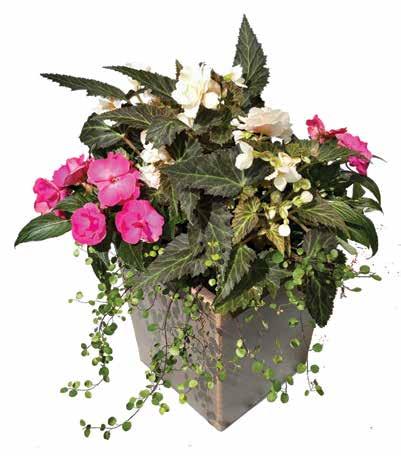

24 June 2024 | kcgmag.com Space Create a
Shrub Sale . $117.00 Annual Begonia Pot $29.99 & up, Braided Hibiscus Tree $39.99 Outdoor Rug $54.99, Kingsley Bate teak Nantucket chair w/cushions $1495.00
a space you can enjoy
friends
family this season
to come.
Create an outdoor space that will help you unwind during your down time. Comfortable and stylish furniture transforms your patio into
with
and
and for many
Combo pots and hanging baskets start at $29.99 Bloomerang Dark Purple Lilac 2gal $24.99 JuneEnds16! suburbanlg.com K-7 & Prairie Star Pkwy (913) 897-5100 135th & Wornall (816) 942-2921 105th & Roe (913) 649-8700
Selection varies by store. Easy on the wallet












































































































































 Photos by Lenora Larson.
Photos by Lenora Larson.



























